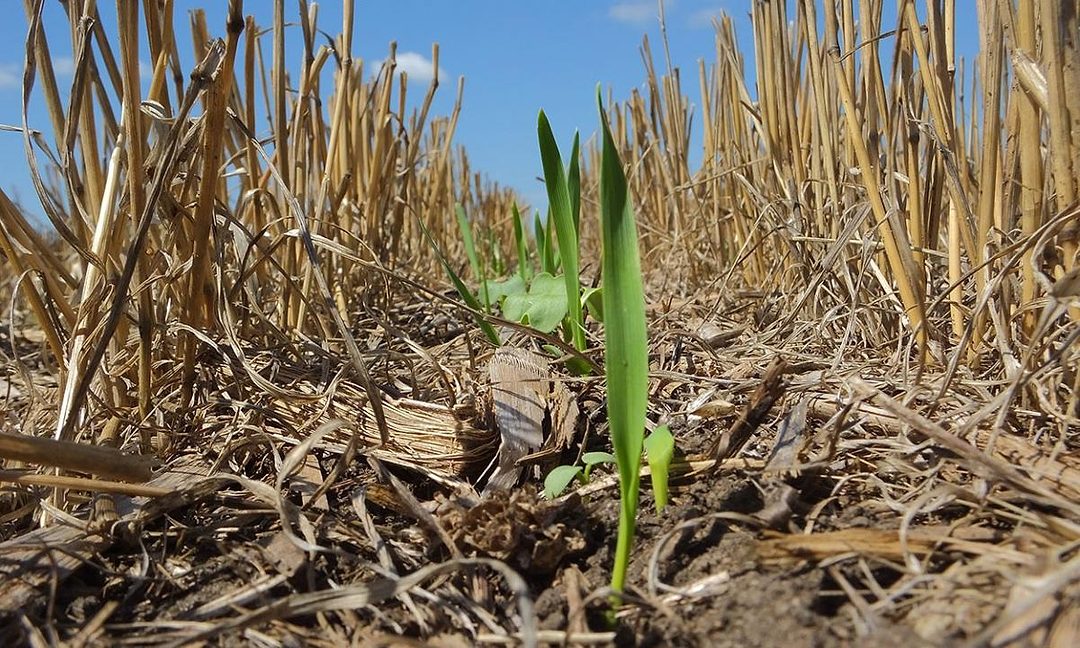By: Dale Younker, NRCS
Much of western Kansas is currently experiencing moderate to extreme drought conditions. What few rains that have fallen recently have been hit and miss thunderstorms where one small area gets a decent rain, but everything around it gets just sprinkles, or nothing at all. Add the unrelenting 100-degree temperatures and the blast furnace winds, it makes for a very hot and dry summer.
Given the current dry conditions you may think that the last thing I would be wanting to talk about is planting cover crops. I’m certainly not advocating that we just put seed in dry soil and hope that at some point it rains enough to germinate and come up. But if mother nature provides an opportunity, planting a cover crop in wheat stubble may be viable option that can provide many benefits down the road.
Much of the success of a wheat sorghum/corn fallow cropping system is reliant on having adequate ground cover during the fallow period to reduce evaporation rates and help suppress weeds. In many areas, this year’s wheat crop was very short and thin, thus not having the cover needed to make this system work as well as it should. At some point, if there is enough moisture to get a cover crop established and get it growing it can help provide the ground cover needed that is currently lacking in these wheat stubble fields.
There also looks to be a significant lack of livestock forage across much of the state. If you are a livestock producer, and the opportunity presents itself, a cover crop that can be grazed or hayed may provide the needed forage to keep the livestock enterprise more intact.
With that said, cover crops will need soil moisture to germinate and grow like any other living growing plant, so it’s a tradeoff. But a mix that is properly designed with the right species, and planted and terminated timely, can mitigate that soil moisture use and other moisture losses during the fallow period.
I would stick with predominately low water use species in the mix. Millets work well in this situation. They are shallow rooted and grow and mature quickly and very drought tolerant once established. Seed cost is reasonable because the seed is small and just a few pounds is all that is needed in a mix. Because of the small seed size planting depth should be no more then about an inch deep so getting these species planted timely after a rain is essential. I would also add a small amount deep rooted species like sunflowers turnips or radishes. They can really help with breaking compaction layers that almost all cropped fields have. Some of these species can also be great habitat for beneficial insects and pollinators. If the planting is delayed until after early-August, oats could be added to the mix. The oats really help feed the soil
biology that is critical to building and maintaining soil aggregates, which in turn increases soil porosity, and can extend the grazing season well into late fall.
Most summer planted cover mixes will frost terminate once temperatures get cold enough in the fall. But if it turns dry it may be appropriate to terminate the cover early so it doesn’t continue to use moisture that may be needed for the next cash crop. This is really a judgement call based on current conditions at the time and long-term weather forecasts.
If you used an herbicide in the growing wheat carryover could be a concern. Many post wheat herbicides that provide long term residual weed control have long plant back restrictions. Always check your herbicide label and if in doubt consult with your supplier or crop advisor.
The Risk Management Agency (RMA) has recently adjusted the crop insurance provisions regarding cover crops and termination guidelines, easing many of the prior restrictions. I would suggest that you contact your crop insurance agent before planting the cover crop to make sure you are meeting all the insurance requirements.
Cover crops will not fit every producer’s cropping strategy and they need to be looked at as just “another tool in the toolbox”. For certain farmers, if properly used, they can provide a lot of soil health and economic benefits, for others not so much. It really boils down to each individual person and what works for them on their farm or ranch.
For more information about cover crops or other soil health practices you can contact me at dale.younker@usda.gov or any local NRCS office.





Post a comment
Report Abusive Comment